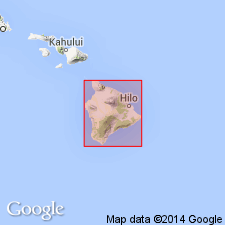
- Usage in publication:
-
- Puna volcanic series
- Modifications:
-
- Original reference
- Dominant lithology:
-
- Basalt
- AAPG geologic province:
-
- Hawaii
Summary:
Pg. 100 (table), 103-110. Puna volcanic series. Olivine basalt with some picrite-basalt. Covers most of Kilauea Volcano and was erupted in Recent and latest Pleistocene time. Rocks on western and southern slopes were mapped as Kamehame basalt, but this name includes lavas from both Mauna Loa (Stearns and Clark, 1930) and Kilauea [Kilauea series of Stone, 1926]; hence, new name is used herein. Series includes a prehistoric member and an historic member. Prehistoric member ranges in thickness from a few feet in a flow on southern slope to more than 410 feet in Uwekahuna Bluff at western edge of Kilauea caldera where base is not exposed. Historic lava flows, erupted since 1750(?), differ only in degree of blackness from the late prehistoric flows. Historic flows are olivine basalts ranging from 1 to 20 feet in thickness on flanks of volcano; flows ponded in caldera are massive and columnar jointed. Correlative with Kau volcanic series on Mauna Loa as both series overlie Pahala ash. Wentworth's (1938) Keanakakoi formation is here treated as "aa" member of Puna volcanic series.
Type locality: walls of Kilauea caldera, Island of Hawaii, HI. Named from Puna district, Island of Hawaii, HI, where rocks of series are most abundant.
Source: US geologic names lexicon (USGS Bull. 1200, p. 3157); GNU records (USGS DDS-6; Menlo GNULEX).
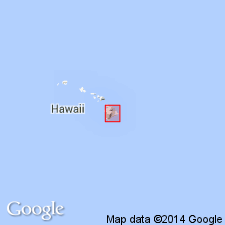
- Usage in publication:
-
- Puna volcanic series*
- Modifications:
-
- Revised
- Adopted
- AAPG geologic province:
-
- Hawaii
Summary:
Pg. 64-72. Puna volcanic series. Includes Uwekahuna ash. Adopted by the USGS.
Source: US geologic names lexicon (USGS Bull. 1200, p. 3157); GNU records (USGS DDS-6; Menlo GNULEX).
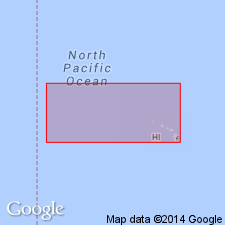
- Usage in publication:
-
- Puna volcanic series*
- Modifications:
-
- Age modified
- AAPG geologic province:
-
- Hawaii
Summary:
No fossils. Flows since 1823 are dated. Assigned late Pleistocene(?) and Recent age.
Source: GNU records (USGS DDS-6; Menlo GNULEX).
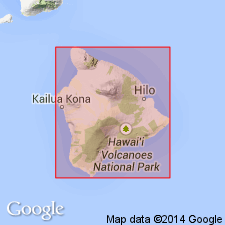
- Usage in publication:
-
- Puna volcanic series*
- Modifications:
-
- Paleomagnetics
- AAPG geologic province:
-
- Hawaii
Summary:
18 flows representing 131 m of stratigraphic section at Uwekahuna Bluff, Kilauea Crater, Island of Hawaii, were sampled. "All lavas now exposed on the island [Hawaii] are less than 1 million years old (Pleistocene)" based on normal direction of magnetization of samples. Age of unit is considered late Pleistocene and Recent.
Source: GNU records (USGS DDS-6; Menlo GNULEX).
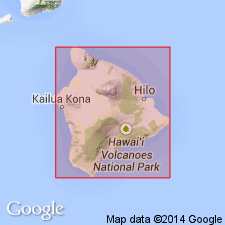
- Usage in publication:
-
- Puna Formation
- Modifications:
-
- Revised
- Geochronologic dating
- AAPG geologic province:
-
- Hawaii
Summary:
Puna Volcanic Series (Stearns and Macdonald, 1946) called Puna Formation. Age of oldest Puna lavas overlying Pahala Formation [Ash] is 10,000 yr B.P. based on carbon-14 dating method (Kelley and others, 1979). Chart shows unit includes Keanakakoi Member (youngest, approx. 2500 yr B.P. to date) and Uwekahuna Member (older, approx 10,000 to 5000 yr B.P.).
Source: GNU records (USGS DDS-6; Menlo GNULEX).
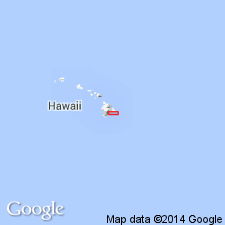
- Usage in publication:
-
- Puna Basalt*
- Modifications:
-
- Age modified
- Redescribed
- AAPG geologic province:
-
- Hawaii
Summary:
Puna Formation (Easton and Garcia, 1980) renamed Puna Basalt to indicate volcanic origin. Includes Keanakakoi and Uwekahuna Ash members. Type section at Uwekahuna Bluff [19 deg 25' 43"N, 155 deg 17' 01"W, Kilauea Crater 7.5' quad] Reference sections: Nanahu Arroyo, Hilina Pali 0.5 km northeast of end of Hilina Pali Road (19 deg 18' 15"N, 155 deg 18' 34"W, Kau Desert 7.5' quad); Kilauea Iki Crater, summit lava (Volcano 7.5' quad); east-rift-zone lava, Makaupuhi Crater (Makaupuhi Crater 7.5' quad); and east-rift-zone lava, Napua Crater (Volcano 7.5' quad). Base of Puna Basalt generally overlies Pahala Ash but locally may be present within Pahala and may be as old as 23 ka.
Source: GNU records (USGS DDS-6; Menlo GNULEX).

- Usage in publication:
-
- Puna Basalt*
- Modifications:
-
- Redescribed
- AAPG geologic province:
-
- Hawaii
Summary:
Puna Formation (Easton and Garcia, 1980) renamed Puna Basalt to show lithology. Type locality at Uwekahuna Bluff Kilauea Crater, Island of Hawaii, HI. Reference localities at Napau, Makaopuhi and Kilauea Iki Craters, and near Keana Bihopa. Unit includes Keanakakoi (younger) and Uwekahuna (older) Ash Members. [see Easton, 1987, this vol]
Source: GNU records (USGS DDS-6; Menlo GNULEX).

- Usage in publication:
-
- Puna Basalt*
- Modifications:
-
- Age modified
- AAPG geologic province:
-
- Hawaii
Summary:
Age of the Puna Basalt is revised from late Pleistocene and Holocene to: Holocene as age of oldest lave flows is considered to be no more than 10,000 years B.P.
Source: GNU records (USGS DDS-6; Menlo GNULEX).
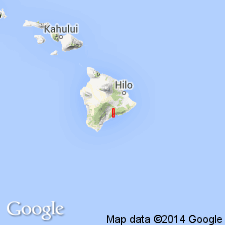
- Usage in publication:
-
- Puna Basalt*
- Modifications:
-
- Revised
- AAPG geologic province:
-
- Hawaii
Summary:
Pg. 724. Uwekahuna Ash, formerly a member of Puna Basalt, is revised and raised to formation rank. Puna Basalt, as defined by Easton (1987), is retained. Underlies, overlies, and interbedded with Uwekahuna Ash.
Source: Publication.
For more information, please contact Nancy Stamm, Geologic Names Committee Secretary.
Asterisk (*) indicates published by U.S. Geological Survey authors.
"No current usage" (†) implies that a name has been abandoned or has fallen into disuse. Former usage and, if known, replacement name given in parentheses ( ).
Slash (/) indicates name conflicts with nomenclatural guidelines (CSN, 1933; ACSN, 1961, 1970; NACSN, 1983, 2005, 2021). May be explained within brackets ([ ]).

